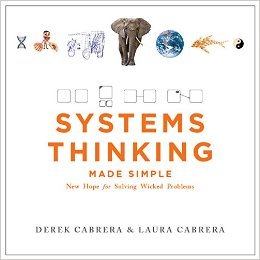Teaching for Thinking and Reflection with DSRP
Economics education often aspires to teach students how to think, not what to think. But what kind of thinking is needed to understand economics? How can we help learners move beyond memorizing definitions or applying abstract models and toward developing a flexible, reflective understanding of the complexity of real world systems? This is where DSRP—Distinctions, Systems, Relationships, and Perspectives—offers both a conceptual guide and a practical method.
Why DSRP?
While many systems thinking approaches emphasize feedback loops and system dynamics, DSRP does not begin with predefined structures. Instead, it invites learners to construct structure through inquiry. This makes it especially well-suited to the study of economic phenomena, where complexity can be made up of causal patterns, relevant actors, behaviours, and all sorts of relationships.
DSRP supports the kind of thinking and reflection that is essential for engaging with complex, embedded, and dynamic systems like the embedded economy. It encourages students to:
- Distinguish: Identify what is and is not part of the system they are studying.
- Systematize: Recognize parts and wholes, and examine how systems are structured.
- Relate: Map both visible and hidden relationships within and across systems.
- Take Perspective: Consider how different actors, observers and angles frame the system.
Applying DSRP in the Classroom
Let’s say students are studying the labour market. A DSRP-based approach might begin not with a textbook definition of ‘labour’ or ’employment,’ but with a set of exploratory questions:
- What do we mean by “labour” or “work”? How do we distinguish paid, unpaid, formal, informal, or precarious work? What distinguishes a wage from a salary, or a fair wage from a minimum wage? (Distinctions)
- What parts make up the labour market? Consider for example employers, employees, unions, job seekers, gig platforms, employment agencies, training institutions, and labour laws. (Systems)
- Who is connected to whom, and in what ways? For example, how do education systems feed into employment systems? How do policy changes affect employer-employee relations? How is the price of labour—wages—negotiated or determined, and what relationships influence that? (e.g. productivity and pay, minimum wage legislation, or union bargaining power). (Relationships)
- How does the system look from the perspective of workers in different sectors, employers, policy makers, migrant workers, or people who are unemployed or underemployed? How do different perspectives understand wage fairness or labour market reforms? (Perspectives)
Students can use sticky notes, whiteboards, or digital mapping tools to represent their evolving understanding. As they build their map, new distinctions lead to new questions, new relationships become visible, and perspectives multiply. The process is dynamic and open-ended.
Instead of asking, “Why is unemployment high?”, students learn to ask, “What structures contribute to patterns of unemployment in different contexts?” and “What would fair or effective wage policy look like from multiple perspectives?”
Why Thinking and Reflection?
In many educational contexts, “critical thinking” is a catch-all phrase. But in the context of economics, it’s more helpful to think in terms of thinking and reflection:
- Thinking is the act of organising information into mental models. Mental models help us interpret and navigate the world.
- Reflection is the ongoing evaluation and re-framing of our mental models. It asks: Is this model still useful? Is it aligned with reality? How might others see it differently?
DSRP explicitly supports this dual movement. It is not about producing a single, fixed system map. Rather, it engages students in an iterative process of refining their mental models—aiming to bring their understanding progressively more in line with the complexity of the real world. Along the way, students become aware of their own assumptions and develop a capacity for deeper, more adaptive understanding.
DSRP and Comparative Learning
Because economic systems and institutions are diverse in structure and logic, students benefit from comparing them. DSRP helps students identify1.
- How distinctions shift between systems (e.g. what counts as “work” or “value” may differ between a cooperative and a corporation).
- How different actor constellations shape economic outcomes (e.g. the roles of community land trusts vs. private developers in housing).
- How relationships vary (e.g. reciprocal, extractive, or regenerative relations between people and land).
- How the same phenomenon (like growth, security, or productivity) is interpreted differently depending on perspective—for example, between a corporate executive and a care worker.
By reusing the DSRP framework across diverse topics—such as energy, care, food, and finance—students develop not only knowledge of each domain but also a meta-cognitive skill set for engaging with any complex socio-economic issue.
Conclusion: Thinking as Design
In the end, DSRP is not just a method for understanding systems—it’s a method for shaping how we think about the systems we are part of. This makes it deeply compatible with the broader goals of economics education: to help learners become thoughtful, capable participants in shaping economic futures.
By foregrounding distinctions, systems, relationships, and perspectives, we help students think more clearly and reflect more deeply. And in doing so, we prepare them not just to interpret the economy—but to imagine and shape its transformation.
A Foundation for Deeper Learning
This article stands on its own as an introduction to DSRP thinking. At the same time, it forms part of a broader series that explores how to redesign economics education around real-world complexity. Later articles will connect DSRP to the idea of systems of provisioning, showing how this flexible thinking method can be applied to a wide range of economic systems—including those that meet our fundamental needs. Together, these articles aim to support an education that builds both understanding and imagination, grounded in reality and open to renewal.
henny@21steconomics.org – You can also find me on LinkedIn
- These examples are inspired by the regenerative design principles that underlie regenerativeeconomics.earth, which offer rich entry points for rethinking economic relationships in terms of reciprocity, stewardship, and interconnectedness ↩︎


